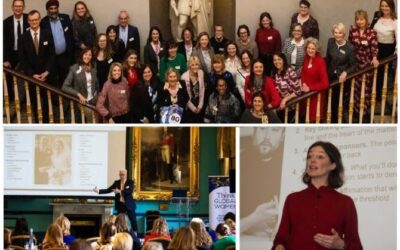AI and inclusion in tech
AI and inclusion was a hot topic at Women in Tech Week as thousands gathered to discuss disparities in the UK tech workforce and solutions to get it where it needs to be.
The UK’s first nationwide women in technology week took place last week, featuring over 70 events on career development and driving forward equality and innovation in the tech industry. Topics included pivoting careers to removing barriers, male allyship and pathways.
As AI continues to redefine the landscape of technology, the need for diverse perspectives has never been more crucial.
A panel moderated by WeareTechWomen founder, Dr Vanessa Vallely OBE, explored the topic of AI and inclusion with an intersectional panel from different tech areas at Cognizant.The panellists shared their individual journeys in tech, and offered a unique lens on how diverse identities including faith, race, gender, economics and sexuality intersect with the fast-evolving world of technology.
The panel
- Lea Bellion, Project Manager
- Esther Duran, Chief Experience, Design & Product Officer
- Azin Fathi, Director of Partner Sales and Expansion
- Yinka Okunlola, Director
- Sinni Simpson, Head of Delivery Management & Operations
15% of the UK’s tech work force is from ethnically diverse backgrounds and gender diversity stands at 19%. Why do you think that is, and what can organisations do to address these gaps?
Azin Fathi: I think some of the root causes in my experience lie in stereotyping at an early age. A common stereotype is that STEM fields are for males. While women are often viewed as carers, or biological carriers, which supposedly make them ‘better suited’ for healthcare or education and ‘less suited’ for areas like engineering or computer science.
AI carries this bias too. If you ask Chat GPT for a description or image of a typical finance worker, firefighter or aerospace engineer it will bring you up a male. AI bias is an issue that many organisations are working on but it’s an ongoing issue.
Another issue we have seen is that ‘bro culture’ is still prevalent in many workspaces, which can make women feel unwelcome or out of place. There is also often an assumption that a female employee may not be able to stay out late for drinks, enjoy golf, or travel.
Promotions is another area that can be influenced by unconscious biases, leading to fewer women being promoted to more senior or leadership tech roles. These promotions can often take place in those more informal settings. It’s not necessarily that male colleagues want to exclude woman, more that many of these sports and activities have historically been occupied by males. However, I do expect my male colleagues to realise the difference they can make consciously, or unconsciously, and to help change it.
There is also a lack of representation. If you look at the top 50 largest tech companies, there are only two female CEOs – Oracle and AMD. That accounts for just 4%. That makes it quite difficult for a young woman to envision themselves in a tech career, or even as a leader.
There are companies making positive strides though. At Cognizant, we have focused on conscious inclusion. Implementing blind recruitment to reduce biases at hiring stage and having more diverse interview panels.
Another impactful solution for us has been mentorship, sponsorship, reverse mentoring programmes, and employee resource groups (ERGs) to empower people and improve the work experiences of different minorities.
At Cognizant, 35% of our workforce belong to one or more of our eight ERGs. But inclusion is not purely the onus of companies, it’s up to us as individuals too.
Yinka Okunlola: As a woman of colour in tech, I think representation is key. Growing up, I barely saw anybody like me in tech. As a girl, I often enjoyed playing with cars, going under the hood and doing activities that seemed reserved for boys. Even my choice to study engineering was considered un-lady like, so representation is really important among black people – we just don’t see enough people like us doing these roles.
I think that also creates a conditioning. When I speak to young girls it’s like they are conditioned to think that they can’t go into tech. My daughters often see me chair a video call full of male colleagues. One of them said she could never do the job I’m doing because she doesn’t believe she can. I know that’s because of what she’s seeing.
In terms of what companies can do, there are definitely practical ways to improve recruitment and promotion. I think lasting change comes from the top down, though. Nordic countries for example, often start by examining gender equality at government level.
It has to come right from the top and trickle down into the companies. If my daughter can’t see more MPs that look like her, how can she see herself as a woman in tech.
How can tech leaders create opportunities for under-represented groups and foster a more inclusive work environment?
Sinni Simpson: It can be quite difficult to create specific opportunities for certain groups of people. The one thing I really focus on when leading my teams is creating an environment where people feel comfortable to be their authentic selves. I think that helps people’s talents to shine and that naturally gives them more confidence to go after opportunities.
I recently joined the Global Leadership Council of Embrace – Cognizant’s LGBTQ+ affinity group. Listening and having conversations with colleagues to deepen my understanding of what’s lacking and then feeding that back to executive leaders, executive sponsors, and the chief people officer, to make meaningful change are all steps we can try to achieve.
Lea Bellion: Affinity groups and having leaders that ensure a psychological safe space are really important.
I’m a member of one for people with disabilities, their caregivers and allies as I was late diagnosed neurodiverse and it’s been really helpful to me. I would urge leaders to encourage their teams to get involved and lean into these sorts of groups and also think about how they can potentially provide better opportunities for these specific groups.
As a leader, listening to all levels of the organisation, as well senior leadership is crucial. We have a round table discussion forum where anyone can put anything up to the senior leadership team and I think that’s a brilliant way of involving all levels of the company.
If you don’t see representation, or ERGs at your work, create something of your own. Although the courage to that comes from having that foundation of psychological safety.
I’m really pleased that I’m a part of an affinity group but there can also be a risk of these being echo chambers, as people in these groups often have an affinity for them. Training sessions, and ensuring inclusive participation and collaboration is key.
Yinka Okunlola: I’ve definitely benefited from ERGs in my career at various companies, although not every company I’ve joined has had them.
It’s a good idea to find out what ERGs your company has that can help you. I asked what affinity groups were available at interview before joining Cognizant and they happily talked me through the options.
If companies genuinely invest in people, they will get their return in people. I’m an example of that. As a leader, anything I learn in these groups I take back into my teams, to educate, strengthen and empower them. The light that you shine gives other people permission to do the same.
How can the potential of AI be harnessed to mitigate biases? And what are the risks of AI perpetuating them?
Esther Duran: In digital, when we talk about tech, what is often missing is empathy. If you put a bunch of tech people in a room, I guarantee that 75-85% of the outcome is going to be lacking empathy. If those people are the ones coding AI, their reflections will be mirrored, featuring a lack of empathy and their bias.
Whenever I do talks, I always encourage every single woman of every colour and background to come forward and be part of the tech industry because we really need to change the narrative, or it will be dark. But we can change it. Mentorship is really important, especially for women, and encouraging them into technical subjects and roles.
Women also need to have some position of power to affect change. When I speak to companies or clients who say they are great at diversity and inclusion, I ask them to show me their board. Change can’t happen on any significant level unless there’s better representation in leadership, it can’t all fall on junior engineers, or data analysts.
Lea Bellion: AI bias has to be addressed but it has potential for creating a fairer working environment too. For instance, in a meeting, AI could potentially be used to help people with disabilities read the room and understand non-verbal cues. It could even help the chair recognise if someone in the meeting was feeling uncomfortable.
In recruitment, as long as the AI is informed by a diverse group of people it could also be positively used to review CVs, and develop a fuller picture of the person applying by searching other factors on the internet.
Stripping names from CVs might prevent some biases, but not others, say if someone was dyslexic and had typos. AI could help create alternative ways to avoid these different biases.







